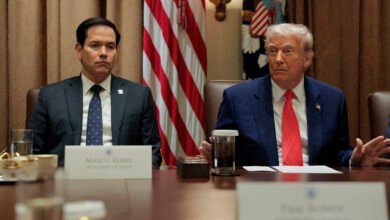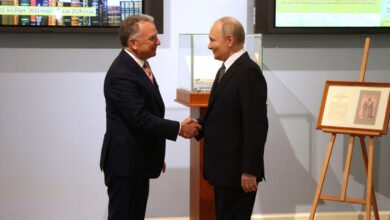Today it is still the case that neither side seems to possess the military capability needed to end the war to its advantage, but there is also no prospect of peace negotiations anytime soon. Ukraine’s summer offensive did not alter the overall state of the war. From the perspective of military history, there is nothing unique about this situation, says lieutenant-general Arne Bård Dalhaug in this reflection.

“While the whole of the Crimean Peninsula is of interest in this context, the bridge over the Kerch Strait is of particular importance”. In this picture, people in Kyiv take selfies in front of an image of a stamp showing explosions on the Kerch Bridge on October 11, 2022. Photo: Ed Ram / Getty Images
Ups and downs in long wars
There are usually ups and downs in long wars – for both sides. One particularly relevant example is the Korean War, during which the fortunes of war shifted significantly more than once. We should also remember that in December 1941, German forces had reached the suburbs of Moscow and Japan’s attack on Pearl Harbor was a catastrophe for the United States. Ultimately, however, both Germany and Japan were comprehensively defeated and both countries were occupied by the victorious powers. These two examples serve to remind us that no one knows whether the war in Ukraine will end next year or after several more years of fighting: we do not know where we are in the war.
It’s not accurate to describe this war as a ‘frozen conflict’, because fighting is widespread and ongoing. No one would think of World War I as a frozen conflict, even though the Western Front, which measured approximately 700 km, remained in pretty much a static position for three or four years. Although some of the largest battles in global history were fought on the Western Front, they never resulted in major breakthroughs for either side.
We have seen a similar scenario over the past year in Ukraine. The Ukrainian commander-in-chief, General Valery Zaluzhny, has made repeated references to the many similarities with World War I. Overall, the situation is characterized by the fact that recent technological developments have favoured defensive operations far more than offensive operations. By using modern technology, including drones, each side has a pretty good idea of what the other is doing. Once you’re detected, you’re under fire. Obviously, this makes it difficult for both the Ukrainians and the Russians to launch attacks.
Events far from the front line may prove decisive
Sir Michael Howard, one of the most eminent military historians of all time, often pointed out that wars are lost or won because of events far from the front line. This is particularly relevant to Ukraine’s war of defence. Ukraine has made some important gains over the past year: it has restricted the operational freedom of the Russian navy in the Black Sea; its grain exports have increased somewhat; and the EU has commenced membership negotiations.
However, Ukraine’s prospects looked brighter a year ago. Even now, a year before Donald Trump’s potential return to the American presidency, uncertainty prevails as to what kind of role the United States will play in Ukraine, and in reality, whether the United States will continue to maintain the global order that Washington established in the wake of World War II.
The EU is also struggling to obtain majority support for its aid packages to Ukraine, and in light of the recent Dutch election, it is expected that the spring elections to the European Parliament will significantly boost the far right.
The conflict in the Middle East is taking both resources and attention away from Ukraine. The presidential election in Taiwan in January will probably lead to a continuation of the country’s current independent political course. This could well lead to increased Chinese aggression, something that would further shift attention away from Europe.
The Ukrainian summer offensive drained into the sand without any notable gains, and Europe is struggling to establish an adequate defence industry. Tensions between Zelenskyy and Ukraine’s military commanders are also increasingly visible, something that is only natural given the stress of the war. None of these considerations means that Ukraine has lost its battle for freedom, but Kyiv has undoubtedly reached a point where it needs to undertake a profound analysis of its strategic options.
Putin has been strengthened in his belief that the West is weak
Putin’s view of the situation is no doubt far more optimistic than it was a year ago. He will be more confident that he was correct to diagnose the West as weak and lacking the willpower needed to provide long-term support to Ukraine. Moscow views current global developments as positive and while the Russian economy has been weakened, it is not doing too badly.
A command economy has been imposed in the military sector and Russia is receiving large quantities of artillery munitions from North Korea. The Russian defensive fortifications have proved robust and Moscow is confident that it can hold on to its territorial gains. Just before Christmas, Putin held his annual press conference. A self-confident Putin asserted that Russia would achieve all its goals in Ukraine, and that peace negotiations were not on the agenda. Only an unconditional capitulation by the Ukrainians would be good enough for Moscow.
Other key Russian officials have confirmed this view. Accordingly, Russia also needs to think carefully about the path ahead, particularly about how it can achieve the occupation of more Ukrainian territory. Occupying more territory will require large-scale offensives. So far, such operations have had little success.
The situation is that both sides need progress on the ground in order to achieve their goals, but at the same time, a sober analysis suggests that such progress will be difficult. In this scenario, both sides need what is known in classical drama as a deus ex machina – a sudden divine intervention that resolves a deadlocked situation. Over the course of history, such interventions have tended to occur more often in theatrical productions than in reality. Even so, the possibility of trend-busting events can never be excluded, for example, a drying-up of military support for Ukraine, or a widespread collapse of discipline among Russian troops, as happened in 1917. The analysis below is based on the assumption that the apparition of any such deus ex machina is unlikely.
No great changes in Russia’s strategy
Putin wants military progress before the Russian presidential election in March this year. Although both sides have limited supplies of artillery munitions, Russia is firing between five and seven times more shells than Ukraine every day. Recently, Russia has launched tactical offensives in several locations along the front line. It is realistic to anticipate some Russian gains in specific areas, but no deep breakthroughs. We also cannot exclude the possibility that Russia will cross the border in places other than where fighting is currently taking place, but this would require it to thin out its troops along the front line. There is little to suggest that Russia will make any fundamental changes to its strategy.
In his monumental novel War and Peace, Leo Tolstoy wrote that the two most powerful warriors are patience and time. The Prussian general and military theorist Carl von Clausewitz wrote that both parties need time, but the important question is who will benefit most from time passing.
Both these observations are relevant to the current war, and not least to Ukraine’s strategy for the future. Remember, we do not know where we are in the war. But we do know that Ukraine’s 2023 summer offensive did not achieve results that altered the Kremlin’s strategic calculations about the progress of the war. The Russian losses were not even close to being of a magnitude that could cause Putin to contemplate abandoning his ambitions for the war.
In other words, Ukraine and the West need a strategy that is likely to inflict several major strategic setbacks on Russia. As this writer has commented several times already, in practice this means that Russian losses of both equipment and personnel will have to be so serious that it becomes obvious that the country will be unable to replace them.
The need for more of everything
Level-headed analysis suggests that a future Ukrainian strategy based on continuing the 2023 summer offensive will have little chance of success, particularly because Kyiv fell pretty far short of achieving decisive results. Accordingly, Ukraine needs to build up a far greater offensive capacity than it had at its disposal in 2023.
The acquisition of more fighter jets will not be enough in itself; Ukraine needs much more of everything. In particular, Ukraine needs to develop the tactics and means to break through large minefields. Far more mine-clearing equipment must be sent to Ukraine. We can assume that the delays and uncertainty concerning future weapons supplies must be complicating Ukrainian operational planning and also causing the postponement of planned activities. There is much to suggest that the Ukrainian authorities share this opinion, and that Zelenskyy has accepted that a phase of strategic defence is now necessary. The question is, for how long?
Some commentators have suggested that Ukraine should take time – namely, the whole of 2024 – to build up its military strength. In practice, this would mean that the next major Ukrainian offensive would take place in spring/summer 2025. Whether Ukraine by that point could succeed in increasing its battle strength relative to Russia’s seems doubtful. And any such a strategy is of course wholly dependent on the West continuing to send a lot of everything, and doing so quicker than Russia succeeds in arming itself.
The Kerch Strait is crucial
Clausewitz introduced the concept of ‘centre of gravity’ – the crucial source from which the enemy takes its strength. An effective attack directed at such a point could have major negative repercussions for the enemy’s ability to continue fighting the war.
While the whole of the Crimean Peninsula is of interest in this context, the bridge over the Kerch Strait is of particular importance (Putin’s Weak Link to Crimea, Foreign Affairs, 5 December 2023).
In fact, destroying the Kerch Bridge before the presidential election could also count as a strike at another centre of gravity in this war, this time of a political nature: Putin himself and his closest henchmen. The destruction of the bridge would represent a serious blow to the regime, and would be seen as a strategic defeat.
The Crimean Peninsula is crucial for supplying Russia’s campaigns in the oblasts of Kherson and Zaporizhzhia. Ukraine also needs to destroy the bridges at Henichesk and Chonhar, which link the Crimean Peninsula to the Ukrainian mainland. Destroying bridges is no easy task. Success will require a large number of long-range precision-guided missiles, primarily American ATACMS and German TAURUS.
In the early hours of 26 December 2023, the Ukrainian Air Force used guided missiles to strike a Russian landing ship, the Novocherkassk, which was at port in Fedosia, less than 100 kilometres from the Kerch Bridge. The ship, which was heavily laden with, among other things, ammunition and drones intended for the front line in southern Ukraine, was totally destroyed. This shows very clearly the potential that lies in Ukraine being supplied with fighter jets, and also enough Western long-range, high-explosive missiles.
The next step in a more offensive strategy is to build up the Ukrainian defence industry so that it can supply highly destructive missiles capable of striking targets within Russian territory. This is necessary because Western countries require guarantees that weapons they provide will not be used against targets within Russia, something which is rather hard to understand given that everything Russia receives from other countries is, of course, intended for use against targets within Ukrainian territory. A longer phase of missile attacks on strategic targets in the Crimean Peninsula could create the necessary conditions for a new large-scale Ukrainian offensive.
The need for a new Western strategy
The front line has now remained in the same place for more than a year, and during this time we have seen a war of attrition. Unless the Western side develops a strategy for exerting tangible pressure on the Putin regime, the most likely development is an unfinished war in Europe, which could continue long into the future. This would be a very undesirable development, but is unfortunately simply an extrapolation from the situation that has already existed for well over a year.
Unless parties on the Western side recognize that a new strategy and strong commitment will be necessary to change the situation, there is unfortunately every reason to assume that Russia will simply continue indefinitely with the same approach to the war as today. As the situation appears now, the Kremlin sees no reason to end the war. All Western hesitation boosts Putin’s belief that NATO and its partners lack the stamina needed to remain involved in the war as long as Russia. Although new supplies of weapons should reach Ukraine, much damage has already happened at a psychological level. Putin is boosted in his belief in victory. It will take a great deal to alter this belief. The situation is serious and time is short.
- Arne Bård Dalhaug: Lieutenant General (Ret.); president of Norges Forsvarsforening (the Norwegian Defence Association – NFF); senior advisor, the Norwegian Atlantic Committee; senior vice president of the Sports Board of the Norwegian Olympic and Paralympic Committee and Confederation of Sports (NIF). Dalhaug served as the Senior Manager for the OSCE Special Monitoring Mission to Ukraine (from 2016 to 2019.
This text was published in Norwegian by Altinget 1 January 2024. The author is a member of the Advisory Board for the PRIO project Russian Approaches to Peace Processes.
Translation from Norwegian: Fidotext
Source link




